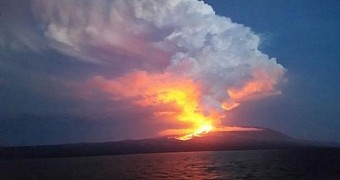This past Monday, in the early hours of the day, the Wolf volcano in the Galapagos Islands erupted, spewing out not just colossal clouds of gas and ash but also massive amounts of lava.
The volcano, located on the archipelago's Isabela Island and measuring about 1.7 kilometers (1.1 miles) in height, last erupted 33 years ago, in 1982, geologists say.
Yesterday's eruption occurred on the volcano's southeast side, where a fissure formed without warning. It is through this fissure that the mountain is now coughing out lava and heated gas and ash.
Interestingly, the 1982 eruption was also due to a fissure spanning over about 1 kilometer (0.6 miles) on one of the volcano's flanks, and it too produced large lava flows.
In a report detailing yesterday's eruption, researchers with Ecuador's Instituto Geofísico - EPN speak of columns of plume reaching an altitude of approximately 15 kilometers (over 9 miles).
The mountain is expected to go on releasing volcanic material for several days before finally calling it quits. For now, geologists can't say for sure when the eruption will end.
As detailed by geologists, this latest eruption was accompanied by significant tremors. Some were strong enough to be recorded by seismometers 20 kilometers (12.5 miles) away from the mountain.
Local communities have nothing to worry about
Since the mountain is located in a deserted region of Isabela Island and is pretty much a loner, specialists reassure that the lava flows will not reach any human communities.
True, they could make it all the way to the ocean and harm local marine ecosystems, but people living on Isabela Island or elsewhere in the archipelago have nothing to worry about.
“The Wolf volcano is not located near a populated area,” Galapagos National Park officials explained in a statement. Furthermore, “There is not risk for the human population.”
What's troubling specialists and especially conservationists is the fact that the lava could destroy the habitat of pink iguanas, a species unique to the archipelago's Isabela Island.
Then again, it looks like these rare reptiles live in a region opposite to the Wolf volcano's cracked southeast flank, so they might escape the eruption unharmed.
Espectacular erupción del #volcánWolf, extremo nororiental de isla #Isabela, en @parquegalapagos Fotos: Diego Paredes pic.twitter.com/Ut4f65vrEt
— Jaime Plaza (@jplazaecu) May 26, 2015
Imágenes de la erupción del Volcán Wolf en las Islas #Galápagos #redgalapagos Gracias a @parquegalapagos pic.twitter.com/d43c4YdNB0
— Radio Encantada (@radioencantada) May 26, 2015
Imágenes de la erupción del Volcán Wolf en las Islas #Galápagos #redgalapagos Gracias a @parquegalapagos pic.twitter.com/QEhbHMzfkY
— Radio Encantada (@radioencantada) May 26, 2015
Técnicos concluyen que al no verse flujos lava activos cerca al mar la actividad de volcán disminuyó Foto @xgalapagos pic.twitter.com/CSygUHzNnj
— Parq. Nac. Galápagos (@parquegalapagos) May 25, 2015

 14 DAY TRIAL //
14 DAY TRIAL //